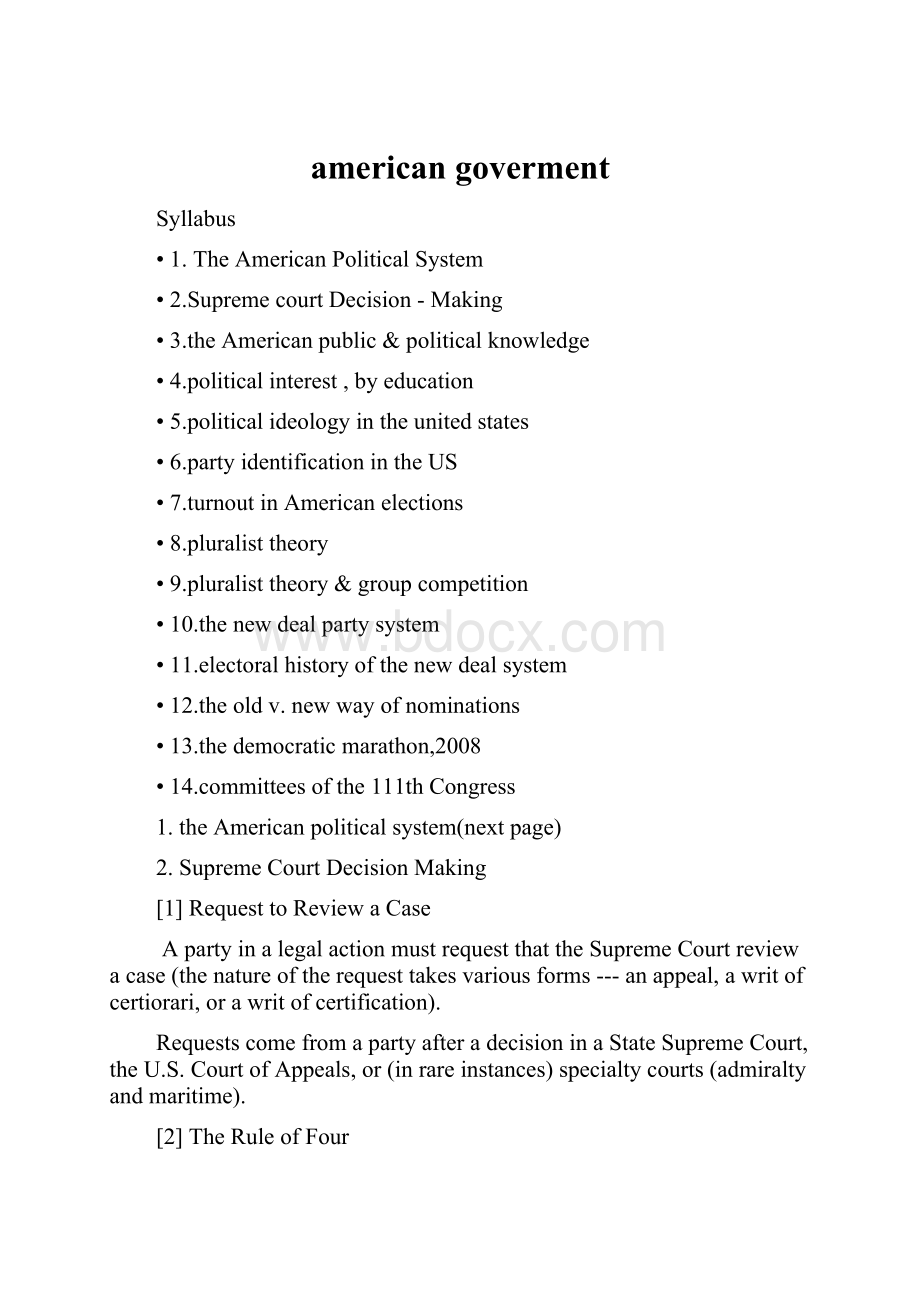american goverment.docx
《american goverment.docx》由会员分享,可在线阅读,更多相关《american goverment.docx(15页珍藏版)》请在冰豆网上搜索。

americangoverment
Syllabus
•1.TheAmericanPoliticalSystem
•2.SupremecourtDecision-Making
•3.theAmericanpublic&politicalknowledge
•4.politicalinterest,byeducation
•5.politicalideologyintheunitedstates
•6.partyidentificationintheUS
•7.turnoutinAmericanelections
•8.pluralisttheory
•9.pluralisttheory&groupcompetition
•10.thenewdealpartysystem
•11.electoralhistoryofthenewdealsystem
•12.theoldv.newwayofnominations
•13.thedemocraticmarathon,2008
•mitteesofthe111thCongress
1.theAmericanpoliticalsystem(nextpage)
2.SupremeCourtDecisionMaking
[1]RequesttoReviewaCase
ApartyinalegalactionmustrequestthattheSupremeCourtreviewacase(thenatureoftherequesttakesvariousforms---anappeal,awritofcertiorari,orawritofcertification).
RequestscomefromapartyafteradecisioninaStateSupremeCourt,theU.S.CourtofAppeals,or(inrareinstances)specialtycourts(admiraltyandmaritime).
[2]TheRuleofFour
FortheSupremeCourttohearacase,theruleoffourprevails.Fourjustices(of9)mustvotetohearacase.Typically,therequestsareexaminedandfilteredthroughthelawclerkshiredbythejustices.Whenacaseseemsparticularlyimportantinraisingaconstitutionalissue,
RulesoftheGame
InterestGroups
“People”
HumanNature“RealWorld”ExpressedOfficeholdersGovernmentPolicy
BackgroundSocialConditionsPublicOpinionElectionCongressAgenda
AbilitiesEvents&Crises--PollsSelectionPresidentOptions
WealthProblems--ProtestsPersuasionSupremeCourtDecision
OccupationMediaReports--WrittenOpinions
ValuesEconomy--Votes
Religion
PoliticalParties
Policy=Agovernment-sponsored“courseofaction”designedtoinfluencethebehaviorofpeople,conditionsintherealworld,&therulesofthepoliticalgame
thejudgesthemselvesexaminetheappealandthendecidewhetheritmeritsreview.
[3]OralArguments
Ifacaseisaccepted,anoralargumentisscheduled.Ontheselecteddate,attorneysrepresentingeachsideinthecaseappearbeforethemembersoftheCourt.Eachsideisallotted30minutestomakeitsargument.Judgesmayaskquestionsandarefreetointerrupttheattorneys.
[4]Conference
Sometimeaftertheoralarguments,thejusticesmeetinconference.Nooneispresentexceptfortheninejustices.Thejusticesdiscussthecase.Followingthediscussion,thereisapreliminaryvote.Givenninejustices,thepossibilitiesare:
9-0,8-1,7-2,6-3,or5-4.Thevoteestablishesamajorityforonesideortheother.
[5]OpinionAssignment
Incertaininstances,theCourtsimplyannouncesitsdecision.Thisiscalledapercuriumdecision.Inthemoreprominentcases,theCourtwillissueawrittenopinionwhichdescribesthequestion,thedecision,andthelegalreasoningbehindthedecision.OpinionsthuspresenttheCourt’sinterpretationoftheConstitution.
Thejusticewhowillwritethemajorityopinionisdeterminedinthefollowingway.IftheChiefJusticevotesinthemajority,hewillassigntheopiniontoajustice(hecanassigntheopiniontohimself).IftheChiefJusticedoesnotvotewiththemajority,themostseniorjusticeinthemajoritywillmaketheassignment.
[6]TheWrittenOpinion
Aftertheassignedjusticewritestheopinion,itiscirculatedamongthejustices.Membershavetheoptionofchangingtheirvoteinlightoftheopinion.Justicesmaysometimesconferwithoneanotherinrevisingtheopinion.Whenthefinaldraftiscompleted,justiceshavetheoptionof“signing”theopinionornot.Justicesalsohavetheoptionofwritingaconcurringopinion.Thisisanopinion,whichagreeswiththeoutcomeandvotebutforreasonsdifferentthanthemajorityopinion.Justicesintheminorityhavetheoptionofwritingadissentingopinionstatingtheirreasonsfordisagreeingwiththemajority.
[7]Announcement:
Ataspecifiedtime,theCourtannouncesitsopinionfromthebench,excerptsoftheopinionsareread,andcopiesofallwrittenopinionsarereleasedand,inaddition,placedontheinternet.
3.theAmericanpublic&politicalknowledge
TheLevelofPoliticalInformationamongtheAmericanPublic
Percent
Question
Year
63%
KnowwhethertheirHouseincumbentisaDemocratorRepublican
1995
60%
Knowthepresidentnominatesfederaljudges
1992
58%
KnowthatRoev.Wadeisaboutabortionrights
1989
58%
KnowthattheSupremeCourtdecidesconstitutionalquestions
1992
57%
KnowthattheRepublicanPartyisthemoreconservativeparty
1992
55%
CannameoneoftwoU.S.Senatorsfromtheirstate
1989
50%
CannamethepresidentofRussia(Yeltsinatthetime)
1994
48%
CannametheSecretaryofState(Powell)
2002
46%
CanidentifythefirsttenamendmentsastheBillofRights
1989
40%
CannametheirrepresentativetotheHouse
1997
34%
Cannamethesecretaryofstate(Albright)
1990
30%
KnowtermofU.S.Housememberistwoyears
1998
29%
CanNametheSecretaryofDefense(Rumsfeld)
2002
25%
CannamebothU.S.Senatorsfromtheirstate
1999
8%
CannametheChiefJusticeoftheUSSupremeCourt
1987
Source:
AdaptedfromRobertEriksonandKentTedin,AmericanPublicOpinion,7thEdition(Table3.1)and6thEdition(Table3.1).
4.politicalinterest,byeducation
Eachelectionyearsince1964,theNationalElectionStudysurveyhasaskedthefollowingquestion:
“Somepeopleseemtofollowwhat'sgoingoningovernmentandpublicaffairsmostofthetime,whetherthere'sanelectiongoingonornot.Othersaren'tthatinterested.Wouldyousayyoufollowwhat'sgoingoningovernmentandpublicaffairsmostofthetime,someofthetime,onlynowandthen,or
hardlyatall?
”
Thisgraphpresentstheaverageproportion(1964-1998)answeringmostorsomeofthetimeforfourlevelsofeducation.
5.politicalideologyintheunitedstates
IdeologyintheAmericanPublic,1973-2006
Year
Extremely
Liberal&
Liberal
Slightly
Liberal
Moderate
Slightly
Conservative
Extremely
Conservative
&
Conservative
AllConservative
Minus
AllLiberal
Don’t
Know
Moderate
Plus
Don’tKnow
Moderate
Don’tKnow
Slightly
1973
18
13
36
13
16
-2
6
42
68
1974
15
14
38
15
13
-1
5
43
72
1975
15
13
38
16
12
0
5
43
72
1976
15
12
37
15
15
3
6
43
70
1977
13
14
37
16
15
4
5
42
72
1978
10
16
36
17
14
5
5
41
74
1980
10
14
40
18
15
9
2
42
74
1982
11
15
39
14
17
5
4
43
72
1984
11
12
39
19
16
12
4
43
74
1985
13
11
37
18
17
11
4
41
70
1986
11
12
39
16
17
10
5
44
72
1988
14
13
35
17
17
7
4
39
69
1989
15
12
37
16
15
4
6
43
71
1990
13
13
35
18
18
10
4
39
70
1991
12
14
39
14
17
5
4
43
71
1993
13
13
36
17
19
10
3
39
69
1994
13
13
35
16
19
9
3
38
67
1996
12
12
36
16
19
11
5
41
69
1998
15
12
35
15
18
6
5
40
67
2000
15
10
38
14
18
7
5
43
67
2002
13
12
38
15
18
8
3
41
68
2004
2006
2008
12
14
15
12
11
11
37
38
37
16
14
13
21
20
20
13
9
7
2
3
4
39
41
41
66
66
65
6.partyidentificationintheUS
PartyIdentification,1952-2004
Year
Democrats
Independents
Republican
Dem
Advantage
1952
47
23
28
19
1954
47
22
27
20
1956
44
23
29
15
1958
49
19
28
21
1960
45
23
30
15
1962
46
21
28
16
1964
52
23
25
27
1966
46
28
25
21
1968
45
30
25
20
1970
44
31
24
20
1972
41
34
23
18
1974
38
37
22
16
1976
40
37
23
17
1978
39
38
21
18
1980
41
34
23
18
1982
44
30
24
20
1984
37
34
27
10
1986
40
33
27
13
1988
35
36
28
7
1990
39
35
25
14
1992
35
39
26
9
1994
34
35
31
3
1996
37
35
27
10
1998
37
36
26
11
2000
34
40
24
10
2002
34
36
30
4
2004
32
39
28
4
2008
36
37
27
9
Source:
CompiledbytheauthorfromNationalElectionStudies.
7.turnoutinAmericanelections
TurnoutinAmericanNationalElections,
1952-2008
PresidentialElections
(PercentofEligibleElectorateCastingaBallotforPresident)
YearTurnout
195262.3%
195660.2%
196063.8%
196462.8%
196862.5%
197256.2%
197654.8%
198054.2%
198455.2%
198852.8%
199258.1%
199651.7%
200054.2%
200460.3%
200862.3%
CongressionalMidtermElections
(PercentCastingaBallotinElectionsfortheHouseofRepresentatives)
195443.5%
195845.0%
196247.7%
196648.7%
197047.3%
197439.1%
197839.0%
198242.0%
198638.1%
199038.4%
199441.1%
199838.1%
200239.5%
200643.6%
8.pluralisttheory
InterestGroups,PluralistTheory,andPolicyMaking
The“logic”ofthissection
(a)Wewillreviewwhatiscalledthe“economic”or“market”modelnotinghowfree
marketsoperate
(b)Assumingmarketsoperateasexpected,theygeneratecertaindesirablefeatures
(c)Thenextsegmentwillshowthat“pluralisttheory”isanattemptto“apply”themarketmodeltointerestgroups;ithingesoninterestgroupcompetitionandisbaseduponthreekeypropositions
(d)Ifthe“politicalmodel”operatesasexpected,thenthepolicymakingprocesswillproduceequallydesirablefeatures
(e)Wewillthen“critique”orcriticallyanalyze“pluralisttheory”
ThePropositionsofPluralistTheory
Proposition#1:
Representation---LeadersandMembers
Leadersareassumed,intheirpoliticalactivity,torepresentthepoliticalbeliefsandpreferencesofthemembershipasitpertainstotheissueathand.Inotherwords,itisassumedthatwhenorganizedlaboropposesatradeagreement,thisoppositionisareflection,inpart,o